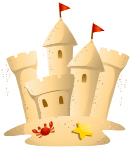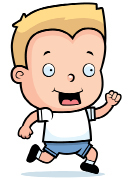Session 2: Intellectual Development
Exploring Environment: A Way to Learn
Focus
Consider the following examples. These examples describe children safely exploring their environments.

© Lorelyn Medina/shutterstock
Example 1: Sand Play
You have added the following materials to the sand table in the four- and five-year-old room: a variety of plastic containers (four of which hold the same amount but are different shapes), sieves, funnels, colourful plastic shovels, and spoons.

Adapted from: © Matthew Cole/shutterstock
Example 2: Fun with Round Things
You have placed Amin on a blanket (he can sit up well by himself but is not crawling yet). Within his reach you have placed a colourful fabric ball, a round squeeze toy, a rolling rattle, and a plastic football. You sit down in front of him to play.

© Cory Thoman/shutterstock
Example 3: Obstacle Course
A mini-obstacle course is set up in one area of the three-year-olds’ room. There is a table with a blanket draped over it for the children to crawl under, a large box for them to jump into and out of, a tunnel for them to crawl through, a wide line made of masking tape for them to walk along, and a small climbing frame for them to climb over. You have made large orange footprints and attached them to the floor to help guide the children from one piece of equipment to the next.
An obstacle course is typically set up for physical development. However, often when a child uses gross or fine motor materials, the child is challenged to also use her or his intellectual skills. It is important for a care provider to be aware of how the child is using the materials and what the child is gaining intellectually by using the materials.
Setting gross motor movement aside, think about how a child might play with each part of the obstacle course. You might think of what three-year-old children might do with the box, the tunnel, the climbing frame, the footprints on the floor, or with a combination of these materials.